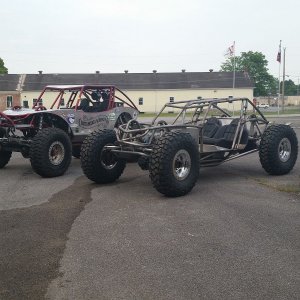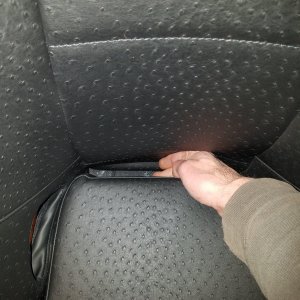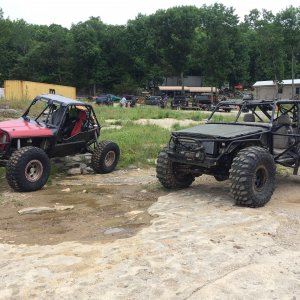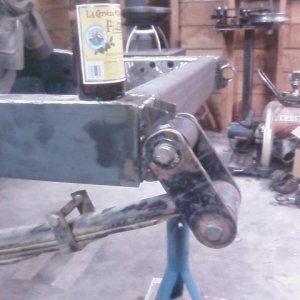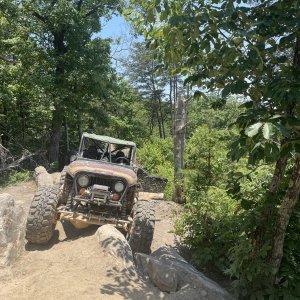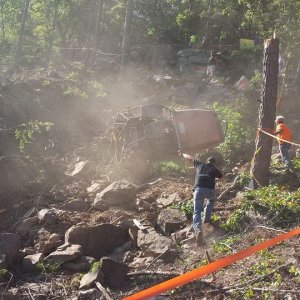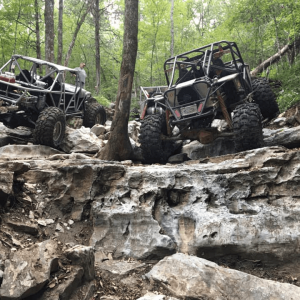You are using an out of date browser. It may not display this or other websites correctly.
You should upgrade or use an alternative browser.
You should upgrade or use an alternative browser.
Looking to get into a TIG machine
- Thread starter patooyee
- Start date
patooyee
Well-Known Member
- Joined
- Sep 27, 2008
- Messages
- 5,692
DCEN.
Today was literally my first day ever holding a TIG torch. I got in 5 hours of practice before I ran out of argon. (Was using a tiny argon tank that was already partially used from a spool gun project.) I only had pure electrodes, which I know aren't best, and I was doing a lot of experimenting. There's just too much that I already know needs to be corrected to bother posting pics. I'll get everything fixed tomorrow when the welding store re-opens and post some then. Right now I'm mainly just looking for pointers on feed technique.
Today was literally my first day ever holding a TIG torch. I got in 5 hours of practice before I ran out of argon. (Was using a tiny argon tank that was already partially used from a spool gun project.) I only had pure electrodes, which I know aren't best, and I was doing a lot of experimenting. There's just too much that I already know needs to be corrected to bother posting pics. I'll get everything fixed tomorrow when the welding store re-opens and post some then. Right now I'm mainly just looking for pointers on feed technique.
Hope Springs Hauler
Well-Known Member
- Joined
- Aug 2, 2013
- Messages
- 86
patooyee said:. Right now I'm mainly just looking for pointers on feed technique.
I'm far from a pro, but I will just dab the filler rod in as needed and otherwise keep it above the weld pool.
SomewhiteGuy
Well-Known Member
- Joined
- Apr 10, 2013
- Messages
- 486
I think you will find your welds look a lot better and is easyier with either a 2% thoraiated or langthited sp?>, I only use pure for al.
1 amp per .001 thickness of the metal is a good starting point for settings.
1 amp per .001 thickness of the metal is a good starting point for settings.
patooyee
Well-Known Member
- Joined
- Sep 27, 2008
- Messages
- 5,692
I was so excited about going in and welding some more today and then someone called in at work and there goes my day. I did manage to make it by the welding store before I went in though to pick up some thoriated (they didn't have lanthanated) tungsten and a bottle of argon. It will be next week before I can go to the shop again now. 
wont work
Well-Known Member
- Joined
- Apr 5, 2010
- Messages
- 1,265
SomewhiteGuy said:I think you will find your welds look a lot better and is easyier with either a 2% thoraiated or langthited sp?>, I only use pure for al.
1 amp per .001 thickness of the metal is a good starting point for settings.
This ^
Green for Al
Red for steel.
Also use pure argon. I also like to walk my cup over my filler when welding so you dont have to dip it in the puddle.
yankster
Well-Known Member
Also set your post flow to 1 second for every ten amps. Tungsten will last much longer.
Eddyj
Well-Known Member
Next time a click on this thread I want to see a stack of dimes.
Patooyee, you seem to be a tech junkie so Im sure you have done more than enough research on the ole interweb on tig welding. There is NO amount of reading that can replace time behind the hood. Everyone has there own style and ways they like to do things some may work for you some may not you need to just start burning rod. Also don't over think it..... Some of the best welders I know have 0 schooling, text book knowledge they just have years of work experience. I think the biggest thing with TIG is cleanliness! This is very basic advice but sometimes (OK) a lot of times is forgotten. Make sure your material is prepped even if your just playing around. Welding through mill scale blows. Keep your tungsten sharp also make sure you are comfortable. If your not comfortable you will struggle to have good travel. If its easier, use some vice grips etc to prop your hand on so you can remain comfortable through the entire pass. Last but not least DONT DIP THE TIP lol Really just go have fun, its not your job.
fl-krawler
Well-Known Member
- Joined
- Aug 27, 2009
- Messages
- 525
As it has already been said.. lanthanated or thoriated tungsten. I use lanthanated for almost everything anymore (both steel and alum.) For steel I like a nice sharp point on the tungsten. For aluminum I grind it to a point, then knock the tip off the point, so that I can get a small aluminum ball to form at the end when I start welding.
patooyee
Well-Known Member
- Joined
- Sep 27, 2008
- Messages
- 5,692
The above pic is the first beads I've laid so far on aluminum. Machine set at 180 amps, 1/8 thoriated, unknown base aluminum, 5356 filler rod. I know why the end of the weld is falling though ... it is because the heats builds up there and has nowhere to go. I've read to add more filler to prevent that but it seems I can't add it fast enough? My tungsten isn't balling, but it doesn't seem to be hurting anything. Instead it is forming little nodules on the tip.
Weird thing, my machine came with two tubes of 5356 filler rods, one seems a bit older than the other. The older tube ABSOLUTELY won't weld, contaminates the ever living **** out of everything whereas the slightly newer tube seems to be doing fine. Any theories on this? Should I trash the older tube?
Input?
Weird thing, my machine came with two tubes of 5356 filler rods, one seems a bit older than the other. The older tube ABSOLUTELY won't weld, contaminates the ever living **** out of everything whereas the slightly newer tube seems to be doing fine. Any theories on this? Should I trash the older tube?
Input?
patooyee
Well-Known Member
- Joined
- Sep 27, 2008
- Messages
- 5,692
sledneck said:Patooyee, you seem to be a tech junkie so Im sure you have done more than enough research on the ole interweb on tig welding. There is NO amount of reading that can replace time behind the hood.
It is true that I like to do research on subjects that interest me. And I have done a ton before starting this, watching hours of video. Unfortunately, I seem to have more time in front of a computer screen than at the shop. But the research has helped me immensely I feel. The other day I was having issues on steel and the internet cleared them right up. But I am having fun under the hood now and am going to get back at it. Thanks!
fl-krawler
Well-Known Member
- Joined
- Aug 27, 2009
- Messages
- 525
patooyee said:The above pic is the first beads I've laid so far on aluminum. Machine set at 180 amps, 1/8 thoriated, unknown base aluminum, 5356 filler rod. I know why the end of the weld is falling though ... it is because the heats builds up there and has nowhere to go. I've read to add more filler to prevent that but it seems I can't add it fast enough? My tungsten isn't balling, but it doesn't seem to be hurting anything. Instead it is forming little nodules on the tip.
Weird thing, my machine came with two tubes of 5356 filler rods, one seems a bit older than the other. The older tube ABSOLUTELY won't weld, contaminates the ever living **** out of everything whereas the slightly newer tube seems to be doing fine. Any theories on this? Should I trash the older tube?
Input?
Is there a reason you are using 5356 filler? IIRC that is more for cast aluminum. Try a 4043 filler and see if you like it better
http://www.millerwelds.com/resources/communities/mboard/forum/welding-discussions/21164-tig-rod-4043-or-5356?20663-Tig-rod-4043-or-5356=
The little nodule is what is refered to as balling. When I weld aluminum I do a technique called chasing the puddle. Put just enough heat into it so the it is about to blow though. Dab the filler to fill the hole that is starting, move forward and repeat
As far as contamination, I keep a designated set of gloves just for the tig, or if I am barehand, I wash my hands before I start welding. I also wash everything down, including my filler with some acetone. If I am in a jam, I will adjust the welder to a higher a/c balance percentage, and do a dry low voltage run over the aluminum. It leaves it that white color that is usually along the outside edge of the weld and usually cleans the aluminum good enough to get minimal contaminates. ***Edit** now looking back at your pics, you need more a/c balance, even in normal welding. The aluminum should have a small white area right along the edge of the weld from the cleaning action as the arc switches direction during a/c operation. Try turning it up to 70% and bump the heat a little to compensate and give it a try
Does your machine have up slope and down slope? Are you cleaning the material and filler rod? If so with what? Looks like you have decent travel speed your not blowing through the base material. Make sure that base material is good and hot, look for it to start puddling up before you even dab in your filler rod then get ready to boogie Alum. Is great you can go from hero to zero in no time lol. Also check and see if your machine has a spark switch if it does try and turn from start only to the on position. Sorry it's been some time since I have used a blue machine.... As much as I like Miller I feel the Lincoln is a much easier machine for the beginner. Miller's have to many options for the novice to mess with and make there job a pain in the ass. Maybe Won't Work will chime in as I thought he said he used Millers.
patooyee
Well-Known Member
- Joined
- Sep 27, 2008
- Messages
- 5,692
I'll post more pics later tonight, I'm about to leave the shop.
Yes, my machine does have balance control and I had good cleaning action (I felt like) but the pic I posted I wire-brushed clean before snapping the pic so I think that scraped away the cleaned area. I start each aluminum weld by using light pedal and letting the ac balance clean the spot before I puddle. Kind of crazy how effective it is. You almost don't need to clean aluminum at all.
I figured out how to keep the puddle from falling through at the edge. It just takes a **** load of rod and feather the amps down slowly.
I ****ing love TIG. I can't believe I waited this long to buy a machine and learn.
I welded on some 16-ga aluminum today, too. I know pulse isn't required but I tried manually pulsing and man things looked better. Kind of wish I had pulse on my machine now. It has the spots for the knobs but the module isn't installed / included.
I finished up the day by going back to steel for a little while. The thoriated tungsten is infinitely better than pure both on aluminum and steel. I've got a ****-ton of pure that came with the machine though. :-/
Getting a lot better at keeping my filler out of the tungsten. I think I only had to stop to resharpen contaminated tungsten twice today.
Yes, my machine does have balance control and I had good cleaning action (I felt like) but the pic I posted I wire-brushed clean before snapping the pic so I think that scraped away the cleaned area. I start each aluminum weld by using light pedal and letting the ac balance clean the spot before I puddle. Kind of crazy how effective it is. You almost don't need to clean aluminum at all.
I figured out how to keep the puddle from falling through at the edge. It just takes a **** load of rod and feather the amps down slowly.
I ****ing love TIG. I can't believe I waited this long to buy a machine and learn.
I welded on some 16-ga aluminum today, too. I know pulse isn't required but I tried manually pulsing and man things looked better. Kind of wish I had pulse on my machine now. It has the spots for the knobs but the module isn't installed / included.
I finished up the day by going back to steel for a little while. The thoriated tungsten is infinitely better than pure both on aluminum and steel. I've got a ****-ton of pure that came with the machine though. :-/
Getting a lot better at keeping my filler out of the tungsten. I think I only had to stop to resharpen contaminated tungsten twice today.
patooyee
Well-Known Member
- Joined
- Sep 27, 2008
- Messages
- 5,692
I was using the 5356 because the machine came with a crap ton of it. I guess that means the previous owner did a lot of cast aluminum welding. It did come with some 4043 and it does a lot better but I need to get some more of it.
This was just practice trying to weld on something round since the genesis of this whole project was a radiator I am about to need to weld some round mounting pucks onto. This was about 3/8 wall welded to 1/4 plate. You can see I was getting the a/c balance action.

Stacking dimes on flat 3/16 plate. The crappy welds at the top were what I was getting when I tried to use that old package of 5356 rods. That crack at the top right made me realize I need to feed a little extra rod at the beginning of each weld, too.

Just seeing how big a gap I could fill if I had to. (I couldn't get my phone to focus on it for some reason.)

Some steel I was playing on my first day. I'm a little better now with the thoriated tungsten. I forgot I took these the other day, didn't take any steel pics today.


This was just practice trying to weld on something round since the genesis of this whole project was a radiator I am about to need to weld some round mounting pucks onto. This was about 3/8 wall welded to 1/4 plate. You can see I was getting the a/c balance action.

Stacking dimes on flat 3/16 plate. The crappy welds at the top were what I was getting when I tried to use that old package of 5356 rods. That crack at the top right made me realize I need to feed a little extra rod at the beginning of each weld, too.

Just seeing how big a gap I could fill if I had to. (I couldn't get my phone to focus on it for some reason.)

Some steel I was playing on my first day. I'm a little better now with the thoriated tungsten. I forgot I took these the other day, didn't take any steel pics today.


patooyee
Well-Known Member
- Joined
- Sep 27, 2008
- Messages
- 5,692
In anticipation of welding the thick mounting bungs to the thin aluminum radiator, I welded this 3/8 wall aluminum tube to 16-ga sheet. I've heard welding thick to thin is a challenege so I figured I would practice before I **** up a new radiator.

Again, wire brushed clean so you can't see the cleaning really.

Again, wire brushed clean so you can't see the cleaning really.
patooyee
Well-Known Member
- Joined
- Sep 27, 2008
- Messages
- 5,692
I've been practicing a lot but only just the other day did everything start really clicking for me. So far what I've learned:
1. My machine welds infinitely better at higher frequencies, so I just keep it turned all the way up. It has a warning on it that high frequencies can damage nearby sensitive computer circuitry but neither my cell phone or shop computer seem to be suffering any consequences so far. I know the modern inverter machines do way higher frequencies than my old Syncrowave transformer so I figure damage is probably a very rare thing.
2. Joint prep is very important.
3. Cleanliness is very important.
4. Mill scale on steel goes way deeper / is way more permanent than I ever realized before. Sometimes you really have to work to get that **** off. I think many people clean steel and think the dark color underneath IS the steel, but if its not shiny and silver you're looking at mill scale.
5. Its all about puddle control. Puddle first, then dab.
6. Welding gaps is possible but generally looks like crap.
7. My machine seems to like pure tungsten for aluminum and thoriated for steel. I have some ceriated that I haven't tried yet.
Here's a switch pod I made for some switches I am putting in the buggy right now to replace the Wired HDH switches:


It will bolt to an overhead tube. It was my first actual project made of 16-ga aluminum that wasn't 100% practice. Here about the best beads I could lay:

The beads on the rest aren't nearly as pretty as these. About 3/4 of the way through that project is when it all started making sense and clicked. I turned my heat up from 30 amps to about 50 and that's when **** really started flowing.
The next day I had to "clearance" my coolant overflow reservoir for a piece of the chassis that it was close to. I was getting cocky now that I had started laying little dimes and hadn't learned the important of joint prep fully yet. So I was filling some gaps around this piece that were pretty big. It looked like crap so I grinded them all smooth and went back over it again. Some of the bigger gaps at the end were still very sensitive so those still look liek crap but you can definitely tell its all starting to click at this point. This piece is where I decided I would send more time on joint prep in the future. This was very thing wall, like 20-ga, with a piece of 2" x .120 wall tube welded across it.
This was very thing wall, like 20-ga, with a piece of 2" x .120 wall tube welded across it.

As everyone knows, I own restaurants. In them we have tons of stainless sinks and counters that get the crap beat out of them. Now and then they need small repairs and I've always wanted a small portable machine to fix them up with instead of paying a mobile welder every time. The mobile welder gets a $150 min. service call fee every time + $125/hr with a 1-hour min. So if he comes out, welds for 15 seconds, its $275 minimum. I even posted a thread about this here a while back. So instead of paying him I bought this machine as well as a small portable argon tank:
http://smile.amazon.com/gp/product/B00H2VETB6/ref=oh_aui_detailpage_o00_s00?ie=UTF8&psc=1
This is a neat little machine because you can get 80 amps out of it (plenty for my fixtures at work) on 110volts and 160 amps at 220 volts. It has HF start and fits in a large briefcase. Its already paid for itself in repairs at work but I'm also going to start practicing welding rollcage tubing with it because it has a finger trigger instead of foot amp control. Yes, the amp control is nice on my big machine but I can't see standing up welding on rollcages on one foot while I control amps with the other. Plus, I think amp control is less imperative on thicker steel like roll cage tubing vs thin aluminum sheet.
Right now my biggest problem is my left middle finger. Early this year it got into a fight with my grinder which resulted in this ...
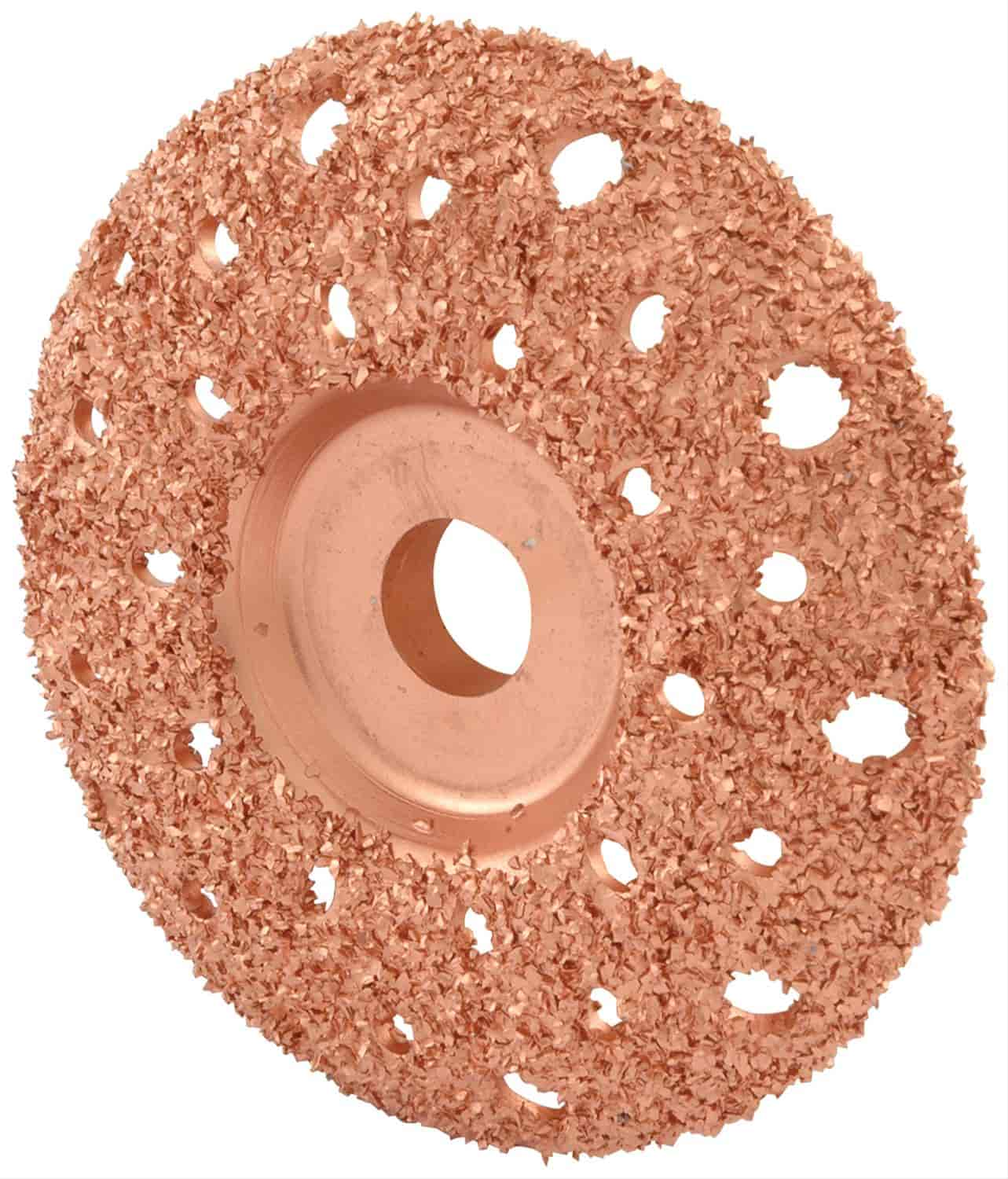
... becoming intimate with the bone in my middle finger. I'm fully healed now but from the scar up that finger is still pretty much numb. It happens to be my filler rod feed finger so I think feeding is taking me longer to master than it migth someone who could actually feel the rod in their hand.
Anyway, that's just an update, maybe someone will have some advice and/or someone in the future will see this and learn from it. I love TIG welding and even when I'm not at the shop I find myself trying to find reasons to go there and TIG on something.
1. My machine welds infinitely better at higher frequencies, so I just keep it turned all the way up. It has a warning on it that high frequencies can damage nearby sensitive computer circuitry but neither my cell phone or shop computer seem to be suffering any consequences so far. I know the modern inverter machines do way higher frequencies than my old Syncrowave transformer so I figure damage is probably a very rare thing.
2. Joint prep is very important.
3. Cleanliness is very important.
4. Mill scale on steel goes way deeper / is way more permanent than I ever realized before. Sometimes you really have to work to get that **** off. I think many people clean steel and think the dark color underneath IS the steel, but if its not shiny and silver you're looking at mill scale.
5. Its all about puddle control. Puddle first, then dab.
6. Welding gaps is possible but generally looks like crap.
7. My machine seems to like pure tungsten for aluminum and thoriated for steel. I have some ceriated that I haven't tried yet.
Here's a switch pod I made for some switches I am putting in the buggy right now to replace the Wired HDH switches:
It will bolt to an overhead tube. It was my first actual project made of 16-ga aluminum that wasn't 100% practice. Here about the best beads I could lay:
The beads on the rest aren't nearly as pretty as these. About 3/4 of the way through that project is when it all started making sense and clicked. I turned my heat up from 30 amps to about 50 and that's when **** really started flowing.
The next day I had to "clearance" my coolant overflow reservoir for a piece of the chassis that it was close to. I was getting cocky now that I had started laying little dimes and hadn't learned the important of joint prep fully yet. So I was filling some gaps around this piece that were pretty big. It looked like crap so I grinded them all smooth and went back over it again. Some of the bigger gaps at the end were still very sensitive so those still look liek crap but you can definitely tell its all starting to click at this point. This piece is where I decided I would send more time on joint prep in the future.
As everyone knows, I own restaurants. In them we have tons of stainless sinks and counters that get the crap beat out of them. Now and then they need small repairs and I've always wanted a small portable machine to fix them up with instead of paying a mobile welder every time. The mobile welder gets a $150 min. service call fee every time + $125/hr with a 1-hour min. So if he comes out, welds for 15 seconds, its $275 minimum. I even posted a thread about this here a while back. So instead of paying him I bought this machine as well as a small portable argon tank:
http://smile.amazon.com/gp/product/B00H2VETB6/ref=oh_aui_detailpage_o00_s00?ie=UTF8&psc=1
This is a neat little machine because you can get 80 amps out of it (plenty for my fixtures at work) on 110volts and 160 amps at 220 volts. It has HF start and fits in a large briefcase. Its already paid for itself in repairs at work but I'm also going to start practicing welding rollcage tubing with it because it has a finger trigger instead of foot amp control. Yes, the amp control is nice on my big machine but I can't see standing up welding on rollcages on one foot while I control amps with the other. Plus, I think amp control is less imperative on thicker steel like roll cage tubing vs thin aluminum sheet.
Right now my biggest problem is my left middle finger. Early this year it got into a fight with my grinder which resulted in this ...

... becoming intimate with the bone in my middle finger. I'm fully healed now but from the scar up that finger is still pretty much numb. It happens to be my filler rod feed finger so I think feeding is taking me longer to master than it migth someone who could actually feel the rod in their hand.
Anyway, that's just an update, maybe someone will have some advice and/or someone in the future will see this and learn from it. I love TIG welding and even when I'm not at the shop I find myself trying to find reasons to go there and TIG on something.


